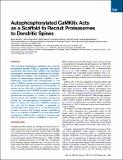Autophosphorylated CaMKIIα Acts as a Scaffold to Recruit Proteasomes to Dendritic Spines
Author(s)
Bingol, Baris; Wang, Chi-Fong; Arnott, David; Cheng, Dongmei; Peng, Junmin; Sheng, Morgan Hwa-Tze; ... Show more Show less
DownloadBingol-2010-Autophosphorylated C.pdf (1.391Mb)
PUBLISHER_POLICY
Publisher Policy
Article is made available in accordance with the publisher's policy and may be subject to US copyright law. Please refer to the publisher's site for terms of use.
Terms of use
Metadata
Show full item recordAbstract
The molecular mechanisms regulating the ubiquitin proteasome system (UPS) at synapses are poorly understood. We report that CaMKIIα—an abundant postsynaptic protein kinase—mediates the activity-dependent recruitment of proteasomes to dendritic spines in hippocampal neurons. CaMKIIα is biochemically associated with proteasomes in the brain. CaMKIIα translocation to synapses is required for activity-induced proteasome accumulation in spines, and is sufficient to redistribute proteasomes to postsynaptic sites. CaMKIIα autophosphorylation enhances its binding to proteasomes and promotes proteasome recruitment to spines. In addition to this structural role, CaMKIIα stimulates proteasome activity by phosphorylating proteasome subunit Rpt6 on Serine 120. However, CaMKIIα translocation, but not its kinase activity, is required for activity-dependent degradation of polyubiquitinated proteins in spines. Our findings reveal a scaffolding role of postsynaptic CaMKIIα in activity-dependent proteasome redistribution, which is commensurate with the great abundance of CaMKIIα in synapses.
Date issued
2010-02Department
Massachusetts Institute of Technology. Department of Brain and Cognitive Sciences; Picower Institute for Learning and MemoryJournal
Cell
Publisher
Elsevier B.V.
Citation
Bingol, Baris, Chi-Fong Wang, David Arnott, Dongmei Cheng, Junmin Peng, and Morgan Sheng. “Autophosphorylated CaMKIIα Acts as a Scaffold to Recruit Proteasomes to Dendritic Spines.” Cell 140, no. 4 (February 19, 2010): 567–578. © 2010 Elsevier Inc.
Version: Final published version
ISSN
00928674